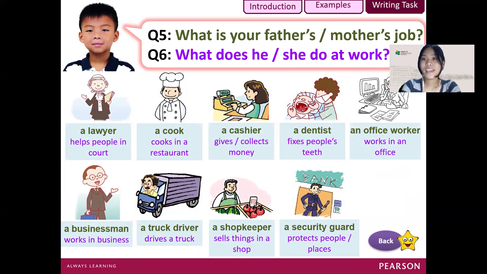Microteaching Insights - Primary
- Grace Wang
- Nov 18, 2024
- 3 min read
Updated: Mar 19
In this series of microteaching lessons, we explore engaging teaching strategies designed to enhance student participation, comprehension, and creativity. Each lesson focuses on a unique approach to learning, ranging from interactive discussions and game-based activities to visual organization techniques. These lessons highlight the importance of active student engagement and personalized learning experiences in developing a stronger understanding of the learning objectives.
The following videos were made by English major students in the primary level teacher education program at The Education University of Hong Kong. They were encouraged to prepare lessons that could be taught online or in the classroom. And – despite the online format – they should strive to engage the students and involve them in meaningful language practice activities. How did they do? Special thanks to Ahmed, Coei and Shella for sharing their lessons with eTEACHERS!
Microteaching 1: What Can We Do in Hong Kong? by Mr Ahmed Awais
Mr Ahmed Awais engages students in a lesson about activities in Hong Kong, comparing them to Japan. He encourages participation through questions and reading exercises, focusing on vocabulary and rhythm in chants. The lesson concludes with students sharing their favorite places and a brief review of the material covered.
00:11 The lesson focuses on introducing Chapter One and exploring activities available in Hong Kong. Students are encouraged to participate actively by sharing their thoughts and engaging in a summary exercise.
02:17 The video demonstrates how to create chants with rhyming words, emphasizing the importance of rhythm and engagement in learning. Rhymes enhance memory retention and make learning enjoyable for students.
03:58 The video features an interactive classroom session where students discuss their preferences and answer questions about their favorite places in Hong Kong, emphasizing participation and engagement.
06:35 Students engaged in a lesson where they read and responded to questions about a chant on an online game-based learning platform – Kahoot!
Microteaching 2: Game-based Learning: Imperatives by Ms Yuen Wing Shan Coei
Game-based learning is emphasized through The Cooking Mama app, where students engage in cooking activities. They explore recipes and learn about sentence structures, particularly imperatives, which are used for instructions, warnings, and suggestions. The lesson encourages students to apply their learning in real-life cooking and share their experiences.
00:07 The lesson focuses on using The Cooking Mama app to guide students in preparing recipes. Students will utilize their shopping lists to cook dishes effectively with step-by-step assistance.
02:28 Students are guided through an interactive cooking exercise, selecting dishes and writing detailed instructions. This activity encourages creativity while reinforcing the previous lessons.
04:47 Learning about kitchen vocabulary and sentence structures can enhance cooking skills and language proficiency. Engaging students with practical cooking tasks reinforces their understanding and application of new concepts.
07:06 Imperatives are sentences that begin with the base form of verbs and can serve different purposes such as giving warnings, orders, and suggestions. Understanding these uses enhances communication effectiveness in various situations.
Microteaching 3: Creating a Mind Map with 6 Question Words by Ms Mak Wai Lam Shella Mae
Ms Mak Wai Lam Shella Mae teaches students how to create a mind map by brainstorming ideas related to "me and my family." The lesson involves organizing thoughts around six questions about age, living location, school commute, and family jobs. It highlights the importance of visual tools in organizing information and enhancing comprehension, providing students with valuable skills for future learning.
00:12 Learning how to create a mind map is essential for organizing thoughts and brainstorming ideas effectively. This process enhances creativity and clarity when tackling specific topics.
02:27 Creating a personal mind map involves placing a central topic and linking related ideas through questions and visuals. This method enhances understanding and retention through creative expression.
04:45 Creating a mind map can help organize information about family members effectively. It encourages adding personal details, making the answers more engaging and informative.
07:04 The video provides a structured approach for primary students to answer questions about their personal information. It emphasizes understanding their living situation, transportation, and family occupations.
09:23 Different professions contribute to society in various ways, including teaching, healthcare, and transportation. Understanding these roles helps recognize the importance of each job in our daily lives.











